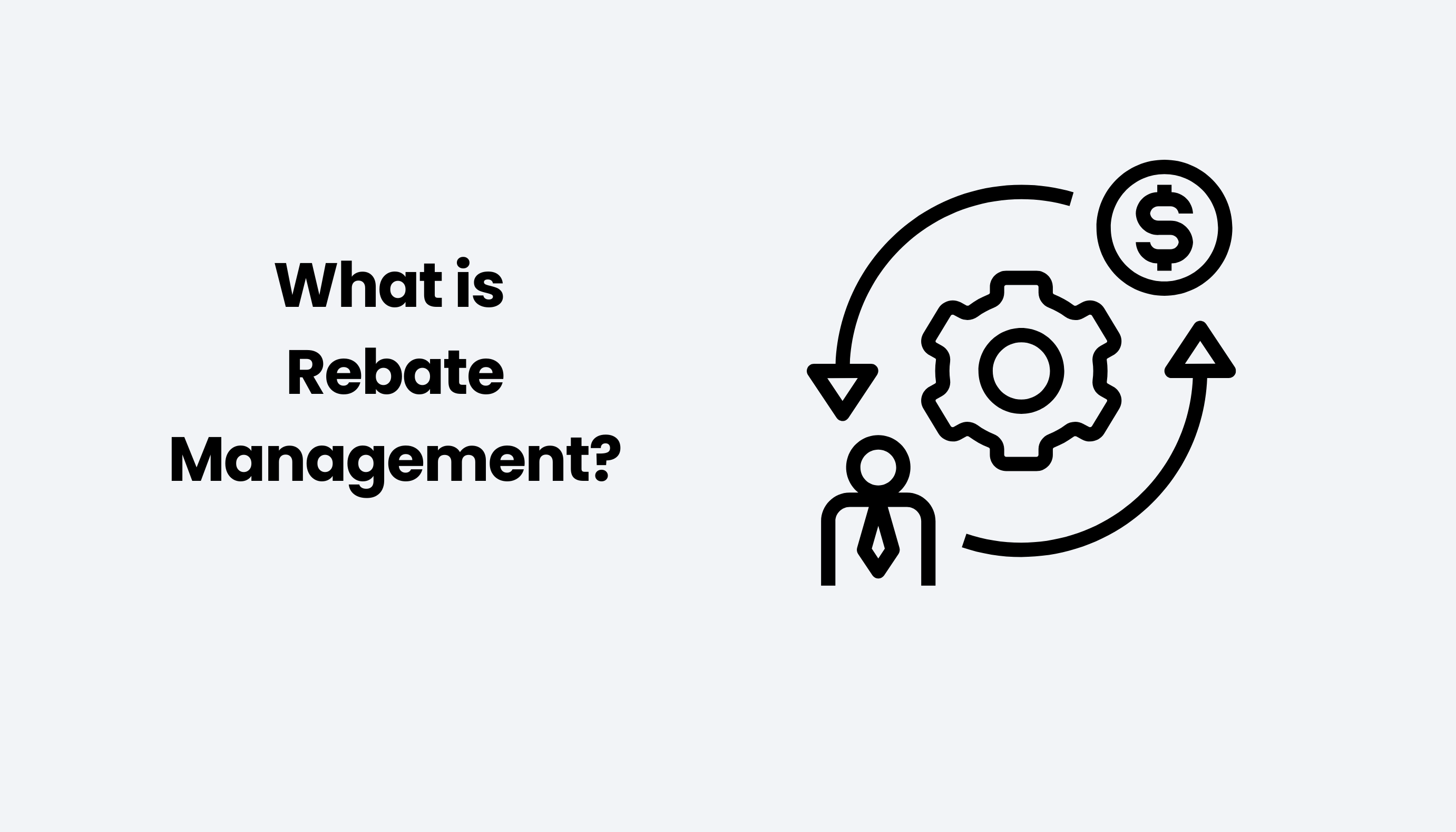What is Rebate Management?

Managing buyer and supplier rebates becomes a complex process when dealing with large volumes of agreements with complex rebate rules. Surprisingly, many organizations still rely on spreadsheets for rebate management, which leads to inefficient processes and opens up the risk of costly errors.
A good rebate management solution provides organizations with the ability to manage multiple rebate schemes, provides full transparency into rebate calculations, and even helps forecast the financial impact of rebate programs.
But why is rebate management important, and how to manage rebate programs effectively? Read further to find out.
Table of Contents:
- What is a Rebate?
- Common Rebate Types
- What is Rebate Management?
- Benefits of Efficient Rebate Management
- Key Components of Rebate Management
- Challenges in Rebate Management
- How to Overcome Rebate Management Challenges Successfully?
- Benefits of using Rebate Management Software
- What is Rebate Processing?
- Accelerate Your Rebate Program Success
Jump to a section that interests you, or keep reading.
What is a Rebate?
Rebates are incentives that suppliers offer buyers to reach designated purchasing goals. After the specified target is met, buyers claim a percentage of the purchase price for a better deal on the order.
Rebates differ from discounts in the sense that rebates are refunds given after a purchase, while discounts reduce the price at the point of sale. A rebate requires the buyer to first pay the full price and then submit a claim to receive money back later, whereas a discount immediately lowers the purchase price.
Common Rebate Types
Rebates can be categorized into several types based on their structure and purpose. Here are some common types:
- Volume-Based Rebates: Offered when a buyer purchases a specific volume of goods within a set period. Incentivizes larger purchases, often with higher rebate percentages for greater volumes.
- Growth Rebates: Designed to encourage year-over-year or quarter-over-quarter sales growth. Buyers receive rebates based on achieving growth targets, promoting sustained increases in purchasing.
- Tiered Rebates: Uses a tier system where higher purchase levels unlock progressively larger rebate percentages. This motivates buyers to purchase more to reach higher tiers and earn greater rebates.
- Loyalty Rebates: Awarded for repeated purchases over time, aiming to foster long-term customer relationships. These rebates typically reward loyal buyers for ongoing business.
- Promotional or Marketing Rebates: Provided to help sellers promote certain products. Buyers earn rebates for supporting marketing efforts, like featuring specific products in advertisements or in-store promotions.
- Retention Rebates: Aimed at reducing customer churn by offering rebates based on the length of the customer relationship or contract renewals. Common in subscription-based models or long-term agreements.
- Conditional or Performance-Based Rebates: Linked to specific performance criteria, such as achieving certain sales targets, timely payments, or adhering to specific quality standards.
- Mix and Match Rebates: Allows buyers to combine different products or services to reach rebate-qualifying thresholds, promoting a broader range of products within the rebate agreement.
Each type serves unique goals, from boosting sales volume and loyalty to promoting specific products, helping suppliers and sellers tailor rebate programs to fit their strategic needs.
Suppliers offer different rebates to different customers tailored to specific purchase volumes, product categories, or contract terms. Managing multiple rebate agreements, tracking performance targets, and ensuring accurate payouts becomes difficult without the right processes in place. This is where rebate management becomes important.
What is Rebate Management?
Rebate management is the process of managing incentives that a company offers to customers or buyers in exchange for their loyalty or purchases. The goal of rebate management is to increase customer satisfaction, boost sales, and build brand loyalty.
Benefits of Efficient Rebate Management
- Enhanced Financial Accuracy and Reduced Errors: Effective rebate management minimizes reliance on manual calculations, reducing errors in financial reporting. Automated systems ensure accurate accounting, thus preventing costly mistakes. Centralized data and real-time tracking also streamline communication across sales, finance, and supply chain departments.
- Optimized Profit Margins: By aligning rebate structures with profitability goals (such as volume or growth-based incentives), businesses can increase revenue without sacrificing margins, leading to higher profitability.
- Improved Partner and Supplier Relationships: Streamlined and transparent rebate processes build trust and improve relationships with partners and suppliers to foster a more collaborative business environment.
- Better Cash Flow Planning: By structuring rebates to align with cash flow goals, businesses can enhance liquidity and maintain more predictable cash flow for a smoother financial planning.
- Compliance and Audit Readiness: Automated rebate tracking ensures adherence to rebate terms and policies, facilitating easier compliance and audit processes. Accurate documentation and reporting help meet regulatory requirements.
- Flexibility for Custom Program Design: Advanced rebate management solutions allow businesses to design and process flexible, customized rebate programs, such as tiered rewards or product-specific promotions for different buyers, to match unique business needs and goals without sacrificing efficiency or accuracy in tracking and payouts.
Key Components of Rebate Management
1. Rebate Agreements and Contracts
Rebate agreements are formal contracts between a business and its partners (suppliers, customers, or distributors) outlining the terms and conditions under which rebates will be granted. These agreements include variables such as volume targets, time frames, product categories, and performance criteria.
Key Elements of Rebate Agreements:
- Terms and Conditions: Defines eligibility criteria, the scope of products or services covered, timelines, and any specific sales targets that need to be met.
- Rebate Structures: Different types of rebates, such as volume-based, tiered, or conditional rebates. These structures dictate the specific circumstances under which rebates are earned, such as reaching a minimum purchase threshold.
- Payment Terms: Details on how and when rebates will be paid, including any specific milestones that need to be achieved before payout.
- Legal and Compliance Requirements: Contracts must comply with laws and industry standards, covering tax implications and ethical business practices.
Challenges with Rebate Agreements:
- Complexity of Terms: Rebate contracts often involve multiple variables, making them difficult to manage manually.
- Custom Agreement Negotiations: Since rebate deals are frequently customized for specific partners, a standardized approach does not apply to all buyers, adding another layer of difficulty for the supplier.
Best Practices:
- Digitize contracts and use automated contract management systems to help manage and track rebate agreement terms with every customer.
2. Rebate Calculation and Tracking
Once rebate agreements are in place, the next critical component is accurate calculation and tracking of rebates. This process ensures that rebate amounts are calculated accurately and tracked throughout the rebate lifecycle.
Rebate Calculation:
- Data Collection: This involves collecting the necessary data, such as sales volumes tied to rebate eligibility.
- Calculation Models: Different agreements require different calculation methods.
- Reconciliation: Regular reconciliation of calculated rebate amounts against actual sales or purchase data to ensure no discrepancies.
Rebate Tracking:
- Performance Tracking: To manage rebates effectively, businesses must continuously monitor performance data to determine if goals are being met.
- Reporting: Real-time dashboards and periodic reports help stakeholders track the progress of rebate programs.
- Audit Trails: Accurate rebate tracking systems maintain an audit trail, documenting how and when rebate calculations were made.
Challenges in Calculation and Tracking:
- Data Complexity: Large volumes of sales or purchase data overwhelm manual tracking systems.
- Data Silos: Without integrated systems, tracking data across multiple departments becomes fragmented and prone to errors.
- Frequent Adjustments: Frequent changes to rebate agreements can complicate the calculation process.
Best Practices:
- Manual rebate calculations are prone to human error, especially when complex variables are involved. Automated rebate calculation systems ensure accuracy in this calculation.
- Automated rebate management software integrates with sales and financial systems to streamline data collection and calculation.
- Provides visibility to all the people involved in rebate performance.
- Such systems are easier to adapt to frequent adjustments in rebate agreements in real-time.
3. Rebate Payouts and Distribution
Once rebates are calculated and validated, the final stage is payout and distribution. This step involves ensuring that rebate payments are calculated correctly, distributed to the right buyer, and properly accounted for in the financial systems.
Rebate Payout Methods:
- Cash Rebates: These are direct payments made to customers or partners based on rebate calculations.
- Credit Rebates: Instead of direct payments, businesses apply rebate amounts as credits toward future purchases or accounts payable, incentivizing repeat business.
Timing of Payouts:
- Periodic Payouts: Many businesses distribute rebates on a set schedule (e.g., quarterly or annually).
- Milestone-Based Payouts: Some rebate programs are tied to the completion of certain milestones (e.g., reaching a sales goal), with payments triggered upon achieving these targets.
Challenges in Rebate Payouts
- Delayed Payments: Delays in processing rebate payouts can strain relationships between supplier and customers, particularly if expectations for quick reimbursement are high.
- Discrepancies in Payout Amounts: Errors in rebate calculations can lead to incorrect payout amounts, resulting in disputes and strained business relationships.
- Compliance with Accounting Standards: Rebate payments must be handled in accordance with proper accounting practices, particularly in terms of revenue recognition and tax treatment.
Best Practices
- Establish clear payout schedules and communicate these with partners to set expectations.
- Use automated payment systems to ensure timely and accurate payouts.
- Ensure that financial records are reconciled with rebate payout data to avoid discrepancies.
Challenges in Rebate Management

Inaccuracies in Manual Rebate Calculations
Rebate calculations are often managed manually across separate systems (spreadsheets and ERP tools), which makes it hard to ensure accuracy, consistency, and timely updates in data. The lack of integration between these systems leads to miscalculations or missed payouts.
Errors in Manual Claim Submissions
Many businesses rely on partners to manually submit rebate claims. This process lacks real-time validation, as errors go undetected until the claims are processed, leading to a high volume of rejected claims.
Partners, in turn, have to re-submit corrected claims, which creates additional back-and-forth that leads to delays in payments and frustration on both sides. These inefficiencies create bottlenecks in rebate fulfilment and also puts a strain on customer and partner relationships.
Lack of Unified View for Rebate Management
In many organizations, rebate program management is highly fragmented, with no central platform to view details of each rebate program and payouts for specific accounts.
Rebate managers and account managers often work in silos and rely on separate systems to track program performance. This lack of integration creates lack of clarity and coordination between different departments or stakeholders. It makes it difficult to align on a company's rebate and sales strategies, such as how to structure rebate programs to incentivize certain behaviors (e.g., increasing sales volume, promoting specific products, or rewarding loyal customers). This leads to missed opportunities that the company could gain from better-structured and more targeted rebate programs.
Sales Reps Lack Visibility into Eligible Rebates
When sales representatives lack real-time access to centralized, up-to-date information about the company's rebate programs, they find it difficult to provide accurate information about the rebates customers are currently eligible for or have already claimed.
As a result, they offer outdated or incorrect rebate details. This discrepancy causes the customer to expect benefits they are not entitled to, or they may miss out on rebates they should be receiving. When the customer later finds out they don’t qualify for the benefit, it leads them to feel misled. Such miscommunications erode your customer trust and damage the overall relationship.
Poor Partner Communication on Rebates
A common issue with rebate programs is the lack of clear communication with partners regarding their eligibility, payout amounts, and timelines. Partners have limited visibility into the rebate programs they are enrolled in, leading to confusion in understanding their eligibility, the exact payout amounts, and the timelines for receiving rebates.
This miscommunication results in missed opportunities to optimize rebate benefits, delayed payments, and an overall deterioration in the partner relationship. Without clear and timely updates, partners feel undervalued and disengaged from the rebate program.
Limited Flexibility in Rebate Program Customization
Many rebate management systems lack the flexibility needed to support the complexity of modern rebate programs. This forces businesses to often simplistic rebate structures that don’t constitute performance-based incentives.
For example, without the ability to customize programs with multiple eligibility criteria, tiered rewards, or transaction-specific payouts, businesses miss out on opportunities to align rebates with growth or revenue objectives, such as increasing sales volume or promoting specific products. This limitation reduces the strategic value of rebate programs.
How to Overcome Rebate Management Challenges Successfully?
Rebate management software solutions allow businessess to quickly and easily implement many different kinds of rebates and personalize them for each customer.
The software automatically tracks sales made against various deals, using real-time calculations to generate detailed reports that allow you to monitor and evaluate rebate performance.
By implementing rebate management software, you can determine which type of rebate to employ – and to whom – to drive desired customer behavior.
Rebate management solutions automate processes and centralize accounting to ensure that everyone involved in the supply chain follows common procedures and practices.
They collect and store all contract data in a centralized, cloud-based location, enable deals to be monitored by all parties, and provide timely and accurate information to sales, purchasing, and finance teams. Anyone with the correct permissions can access all these data from anywhere and anytime, giving everyone full visibility into every rebate calculation and agreement terms while eliminating reliance on mistake-prone manual processes.
The best rebate management solutions also come with deal modeling tools to draft any new deals in advance. You can fully understand the financial implications of any rebate you offer before agreeing to it with the customer. In this way, you are able to see if a proposed deal will meet your business objectives and how your margins will be impacted.
Benefits of using Rebate Management Software

-
Automation of Complex Calculations: Rebate management software automates the calculation of accruals and payouts, reducing manual errors and saving time, especially for complex rebate structures.
-
Centralized Data Management: All rebate-related data, such as customer information, sales transactions, and claim submissions, is centralized in one system. This improves accuracy and provides a single source of truth for reporting and auditing.
-
Automated Management Workflows: Configurable workflow will ensure that all agreements are audited, approved and signed off by appropriate parties promptly. Automated notifications can also be set to alert relevant individuals whenever a signoff is required so that all rebate actions take place consistently and all your rebates are being proactively tracked and managed.
-
Reduces Errors in Claim Submissions: The software’s built-in error detection system helps identify common mistakes in rebate claim submissions, such as missing information or incorrect data. By flagging these issues early, businesses can ensure that claims are corrected and resubmitted before they cause delays in the payout process.
-
Offers Scalability and Flexibility: Rebate management software offers flexible and scalable solutions for managing various rebate structures, from simple discount-based programs to complex, multi-tiered rebates based on sales volume, product categories, or geographic regions. The platform can be easily customized to accommodate different business models, product lines, and customer segments.
-
Ensures Timely Payments and Reconciliation: Timely payouts are crucial for maintaining positive relationships with partners and customers. Rebate management software automates payment schedules, ensuring that rebates are processed and paid out within the agreed-upon time frames. The software simplifies the reconciliation process by accurately tracking all rebate-related transactions and matching payouts to claims. This reduces the time and effort required to reconcile rebate payments, improves cash flow management, and ensures that buyers receive their rebates on time.
-
Improves Partner and Customer Satisfaction: A key feature of rebate management software is the self-service portal that provides partners and customers with easy access to rebate program details. Users can check the status of their rebates, view payout timelines, and get answers to common questions without needing to contact support. This level of transparency and convenience leads to higher satisfaction among customers.
What is Rebate Processing?
Rebate processing is central to executing a successful rebate program. It covers each step from rebate offer creation to customer reimbursement. Through well-defined stages, rebate processing ensures that both customers and vendors receive the intended benefits of the rebate program.
How Rebates Get Processed?
- Rebate Program Setup: This foundational phase involves defining the program’s structure, terms, and conditions, including eligibility criteria, rebate levels, and clear objectives aligned with the program’s goals.
- Assigning Rebate Deals to Customers: In this step, specific rebate deals are assigned to eligible customers based on criteria such as purchase history or volume thresholds. This personalized approach ensures incentives align with customer behaviors and business objectives.
- Tracking Sales and Generating Accruals: Ongoing sales are tracked against each customer’s account to monitor their progress toward meeting rebate conditions. Accruals are then calculated based on these tracked sales, setting aside funds to cover anticipated rebate claims.
- Processing Payments: Once customers meet or exceed their accrual targets, payment processing begins. Verified rebates are disbursed through selected methods—such as checks, electronic transfers, or digital payouts—to ensure customers receive their incentives promptly.
- Program Analysis and Feedback: After rebate disbursements, a thorough evaluation is conducted to analyze the program’s quantitative and qualitative results. This analysis provides valuable insights for refining future rebate programs, aligning them even more closely with business goals.
Accelerate Your Rebate Program Success
Implementing a robust rebate management system offers the infrastructure businesses need to manage multiple rebate programs with multiple buyers effectively. It ensures that rebate calculations, tracking, and payouts are accurate to prevent costly errors and maintain strong partner relationships. A dedicated rebate management system like Speedy Labs will make it easy to track complex rebates and ensure that all rebate calculations, submissions, and payouts are processed accurately.
Get in touch today with us today to find out more about how Speedy Labs can help simplify and improve your rebate management.
